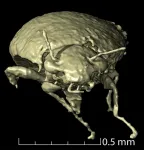(Press-News.org) Don't let the great snipe's pudginess fool you. A stocky marsh bird with a 20-inch wingspan, great snipes are also speedy marathoners that can migrate from Sweden to Central Africa in just three days, without even stopping to eat, drink, or sleep. Now, researchers find that the snipes also rise nearly 2,500 meters in elevation at dawn and descend again at dusk each day, perhaps to avoid overheating from daytime solar radiation by climbing to higher, cooler altitudes. The findings appear June 30 in the journal Current Biology.
The birds also spent much more time in higher elevations than previously thought: during its migration, one bird flew at nearly 8,700 meters (almost as high as Mount Everest) for five consecutive hours, which may be the highest altitude ever recorded for a tracked migrating bird.
"Anyone who studies animal behavior will often find that there is huge variation between individuals. But these birds almost do the exact same thing," says lead author Åke Lindström, a professor in the biodiversity department at Lund University in Sweden. "In the great snipe's migration pattern, we found a very, very strong diel cycle--higher at day, lower at night. They seem to have found a behavior that's really optimal for them."
The great snipes are no strangers to long flights, flying 6,000 kilometer nonstop from breeding grounds in Sweden to Africa's Sahel region for a monthlong stopover in autumn, traveling 1,500-3,000 kilometers within Africa to their final wintering grounds, and migrating 5,200 kilometers back to Southeast Europe in the spring. But until now, scientists have only been able to get a sneak peek of the birds' journeys.
Previous research tracked the birds only when they passed in range of radar, so scientists commonly assumed that the snipes--and many other birds--maintained a steady, favorable cruising altitude to minimize energy loss. But thanks to new technology, scientists can now track birds throughout their entire migration.
In this study, Lindström and his team attached mini data-loggers, weighing only about 1% of the birds' total body mass, to the legs of 14 snipes. The loggers recorded measurements on activity, air pressure, and temperature every hour during their flights.
The researchers found a distinct pattern in all three seasonal migrations. After a night at moderate to high altitudes, the birds ascended to very high altitudes at dawn, stayed at those high altitudes during the day, and descended again in late afternoon or evening to heights similar to the previous night. The snipes typically flew at about 1,600-2,100 meters above sea level at night and 3,900-4,500 meters above sea level during the day.
But why the snipes change their elevation depending on time of day remains an unanswered question. Wind conditions or speed, which are usually the primary factors that influence migration, do not consistently change between day and night. The presence of the sun, however, does--leading to three possible explanations.
First, although flying higher in daylight could help the snipes find landmarks, migratory birds are known to be excellent navigators that don't need to rely on the physical landscape for directions. Higher elevation during the day could also help the snipes escape the range of birds of prey that hunt during the daytime.
But the most likely reason for this daily elevation change comes from the sun's warmth. When flying, the great snipes flap their wings seven beats per second, generating large amounts of body heat. At night when temperatures are cooler, this isn't a problem. But during the daytime, the sun's rays most likely increase their body temperature even more. "When the sun comes up, there is also solar radiation to consider: imagine the difference in temperature when you sit in the shade versus when you sit in the sun," explains Lindström.
Flying more than 2,000 meters higher during the day, where the air is 13 degrees Celsius (55 degrees Fahrenheit) cooler, therefore, might help the birds keep from overheating.
But the snipes also ascended farther than the researchers had ever expected. They repeatedly reached heights of over 6,000 meters, and one bird flew at nearly 8,700 meters--only about 150 meters lower than the summit of Mount Everest. Though conditions above 8,000 meters are brutal for humans, the great snipes seemed to have it figured out.
"They are already way ahead of humans in terms of lung capacity and supplying muscles with oxygen," Lindström says. "If you asked the average great snipe how and why they can fly so high, and if they could answer, they'd probably just be surprised by the question. They wouldn't understand that they have done anything special."
INFORMATION:
This work was supported by the Centre for Animal Movement Research at Lund University, the Crafoord Foundation in Lund, Lunds Djurskyddsfond, and Olle Engkvists Stiftelse.
Current Biology, Lindstrom et al.: "Extreme altitude changes between night and day during marathon flights of Great Snipes." https://www.cell.com/current-biology/fulltext/S0960-9822(21)00745-4
Current Biology (@CurrentBiology), published by Cell Press, is a bimonthly journal that features papers across all areas of biology. Current Biology strives to foster communication across fields of biology, both by publishing important findings of general interest and through highly accessible front matter for non-specialists. Visit http://www.cell.com/current-biology. To receive Cell Press media alerts, contact press@cell.com.
Election outcomes are notoriously difficult to predict. In 2016, for example, most polls suggested that Hillary Clinton would win the presidency, but Donald Trump defeated her. Researchers cite multiple explanations for the unreliability in election forecasts -- some voters are difficult to reach, and some may wish to remain hidden. Among those who do respond to surveys, some may change their minds after being polled, while others may be embarrassed or afraid to report their true intentions.
In a new perspective piece for END ...
30 June 2021: A large cohort study drawn from the national IVF registry of France, which included almost 70,000 pregnancies delivered after 22 weeks gestation between 2013 and 2018, has found a higher risk of pre-eclampsia and hypertension in pregnancies derived from frozen-thawed embryos. This risk was found significantly greater in those treatments in which the uterus was prepared for implantation with hormone replacement therapies. The results confirm with real-life data what has been observed in sub-groups of patients in other studies.
The results are presented today by Dr Sylvie Epelboin from the Hôpital Bichat-Claude Bernard, Paris, at the online annual meeting of ESHRE. The study was performed on behalf ...
The tiny beetle Triamyxa coprolithica is the first-ever insect to be described from fossil faeces. The animal the researchers have to thank for the excellent preservation was probably the dinosaur ancestor Silesaurus opolensis, which 230 million years ago ingested the small beetle in large numbers.
In a recently published study in Current Biology, vertebrate palaeontologists from Uppsala University and entomologists from National Sun Yat-sen University (Taiwan), Friedrich-Schiller-Universität Jena (Germany), and Universidad de Guadalajara (Mexico) used synchrotron microtomography to 3D-reconstruct the beetles while they were still trapped within the fossilised faecal matter. The coprolite contained abundant beetle body parts, most belonging to ...
Harpy eagles (Harpia harpyja) - which are among the world's largest eagle species - struggle to feed offspring in heavily deforested areas of the Amazon, according to a study published in Scientific Reports.
Everton Miranda and colleagues found that harpy eagles rely on specific prey that lives in canopy forests, including sloths and monkeys. Eaglets starved in areas of high deforestation where canopy-based food was limited.
The authors observed prey species, how frequently prey was delivered, and estimated the weight of prey in 16 harpy eagle nests in Amazonian forests in Mato ...
ROCKVILLE, MD, USA - June 30, 2021 - Researchers from Sanaria® Inc. and the National Institutes of Health (NIH) are making progress in the development of highly protective malaria vaccines.
In an article published today in Nature, Sanaria's PfSPZ-CVac (CQ) vaccine is reported as being safe and protecting 100% of six subjects against a variant malaria parasite three months after their last dose in the company's Phase 1 safety and efficacy trial. This is the first time complete protection against a variant malaria parasite has ever been achieved that long after vaccine administration.
The ...
Many neurodevelopmental disorders share similar symptoms, such as learning disabilities or attention deficits. A new study from MIT has uncovered a common neural mechanism for a type of cognitive impairment seen in some people with autism and schizophrenia, even though the genetic variations that produce the impairments are different for each condition.
In a study of mice, the researchers found that certain genes that are mutated or missing in some people with those disorders cause similar dysfunctions in a neural circuit in the thalamus. If scientists could develop drugs that target this circuit, they could be used to treat people who have different disorders with common behavioral ...
In 1934, physicist Eugene Wigner made a theoretical prediction based on quantum mechanics that for 87 years went unseen.
The theory suggested how a metal that normally conducts electricity could turn into a nonconducting insulator when the density of electrons is reduced. Wigner theorized that when electrons in metals are brought to ultracold temperatures, these electrons would be frozen in their tracks and form a rigid, non-electricity conducting structure -- a crystal -- instead of zipping around at thousands of kilometers per second and creating an electric current. Since he discovered it, the ...
Researchers have found that eating disorder behaviors, such as binge-eating, alter the brain's reward response process and food intake control circuitry, which can reinforce these behaviors. Understanding how eating disorder behaviors and neurobiology interact can shed light on why these disorders often become chronic and could aid in the future development of treatments. The study, published in JAMA Psychiatry, was supported by the National Institutes of Health.
"This work is significant because it links biological and behavioral factors that interact to adversely impact eating behaviors," said Janani Prabhakar, ...
Neuroscientists at UCL have, for the first time, identified abnormalities in the way memories are 'replayed' in the brains of people with schizophrenia; researchers say the pathbreaking study provides an entirely new basis for explaining many of the condition's core symptoms.
Schizophrenia is a serious and debilitating mental disorder characterised by episodes of psychosis. Symptoms include hallucinations (typically hearing voices), delusions, and disorganised thinking. It affects around 20 million people globally, though the exact cause is unknown.
In the study, published in the journal Cell, researchers used state-of-the-art ...
A new study by investigators from Brigham and Women's Hospital examines the associations between wealth mobility and long-term cardiovascular health. The multidisciplinary study borrowed methodology from the field of economics to analyze longitudinal changes in wealth. The team's results indicate that negative wealth mobility is associated with an increased risk of cardiovascular events, while positive wealth changes are associated with a decreased risk of cardiovascular events. Their results are published in END ...


